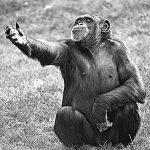Definition
noun, plural: monkeys
Any of the long-tailed, dry-nosed primates but excluding the prosimians
Supplement
Monkeys are primates with the exclusion of the prosimians. Prosimians have relatively primitive features as exemplified by lemurs, lorisoids, tarsiers, adapiforms, and non-simian omomyids. They are characterized by having a long tail and for being haplorrhine (i.e. dry-nosed). There are references that use the terms monkeys and apes interchangeably. However, stricter usage of the terms would delineate apes and monkeys as separate and distinct groups of primates.
Monkeys may be classified into two major groups: (1) New World monkeys and (2) Old World monkeys. A feature common between these two groups is having a long tail. Nevertheless, the New World monkeys have a prehensile tail whereas the Old World monkeys have a tail that is not prehensile. The New World monkeys (platyrrhines) include marmosets, tamarins, capuchins, squirrel monkeys, owl monkeys, titis, sakis, uakaris, woolly monkeys, etc. The pygmy marmoset is considered as the world’s smallest monkey. The Old World monkeys (family Cercopithecidae) include macaques, baboons, mandrills, talapoins, colobus monkeys, guenons, langurs, mangabeys, patas, and talapoins.
Scientific classification:
- Kingdom: Animalia
- Phylum: Chordata
- Class: Mammalia
- Order: Primates
- Suborder: Haplorhini
- Infraorder: Simiiformes (Haeckel, 1866)
See also:
Related term(s):
- Mason-pfiser monkey virus
- Monkey-bread
- Monkey hand
- Yaba monkey virus







